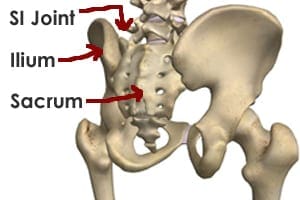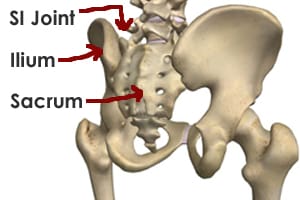statFor some women, it's about making an elegantement at special events or being a couple…

Anatomy of the Sacroiliac Joint
 The sacroiliac joint is a planar (sliding) synovial joint in the bony pelvis, formed by the meeting of the sacrum (at the base of the spine) and upper part of the hip (ilium). Two such joints are found in the human body on either side of the sacrum and they move as a unit, such that movement on one side will produce movement on the other side. The bones connect at their respective auricular surfaces on the outside of the sacrum and inside of the ilium, with a raised area of bone known as the sacral tzygoteuberosity that is connected to the hip bones. The alignment of bones against each other provides support for the joint, and this is greatly enhanced by the presence of several especially strong ligaments.
The sacroiliac joint is a planar (sliding) synovial joint in the bony pelvis, formed by the meeting of the sacrum (at the base of the spine) and upper part of the hip (ilium). Two such joints are found in the human body on either side of the sacrum and they move as a unit, such that movement on one side will produce movement on the other side. The bones connect at their respective auricular surfaces on the outside of the sacrum and inside of the ilium, with a raised area of bone known as the sacral tzygoteuberosity that is connected to the hip bones. The alignment of bones against each other provides support for the joint, and this is greatly enhanced by the presence of several especially strong ligaments.
Although allowing for some degree of tilting movement (between approximately 2 and 18 degrees), the primary role of the sacroiliac joint is to support the weight of the spinal column and upper torso and act as a spinal shock absorber. Anything other than anterior to posterior (back and forth) movement is prohibited by the presence of strong ligaments between the sacrum and ilium, but sacral flexion (bending) and extension (straightening) is possible. The sacrum and ilium may also tilt in opposing directions, as occurs during walking.
The space between the sacrum and ilium tends to become smaller with age, restricting what motion there is, with the bones even occasionally fusing together. Joint flexibility is, however, enhanced in pregnancy as a result of elevated levels of the hormone relaxin, which loosens the ligaments of the pelvis in preparation for childbirth.
The auricular (‘ear shaped’) surfaces of the sacrum and ilium are rough and lined with cartilage. The sacral auricular surface supports hyaline cartilage, whereas fibrocartilage lines the iliac auricular surface. Only the lower half of the joint has a synovial cavity, with the upper half being held in place by the interosseous ligaments and the thick posterior and thinner anterior sacroiliac ligaments. The interosseous ligaments are very strong, and the bone will often fracture before these will tear. Thick posterior and thinner anterior sacroiliac ligaments also support the sacroiliac joint, and the sacrospinous and sacrotuberous ligaments further connect the sacrum to the hip bone. The entire joint is contained and supported by a fibrous articular capsule.




